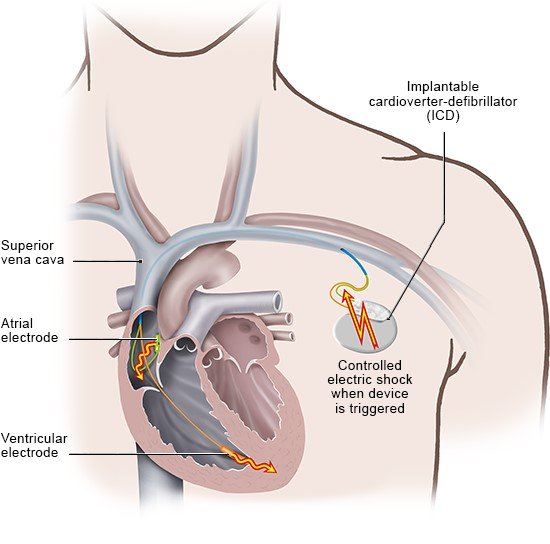Al-Khatib SM, Stevenson WG, Ackerman MJ et al. 2017 AHA/ACC/HRS Guideline for Management of Patients With Ventricular Arrhythmias and the Prevention of Sudden Cardiac Death: Executive Summary. Circulation 2018; 138(13): e210-e271.
Anderson RD, Ariyarathna N, Lee G et al. Catheter ablation versus medical therapy for treatment of ventricular tachycardia associated with structural heart disease: Systematic review and meta-analysis of randomized controlled trials and comparison with observational studies. Heart Rhythm 2019; 16(10): 1484-1491.
Clark AM, Dryden D, Hartling L. Systematic Review of Decision Tools and Their Suitability for Patient-Centered Decisionmaking Regarding Electronic Cardiac Devices (AHRQ Technology Assessment Program). 2012.
Claro JC, Candia R, Rada G et al. Amiodarone versus other pharmacological interventions for prevention of sudden cardiac death. Cochrane Database Syst Rev 2015; (12): CD008093.
Cronin EM, Bogun FM, Maury P et al. 2019 HRS/EHRA/APHRS/LAHRS expert consensus statement on catheter ablation of ventricular arrhythmias. Europace 2019; 21(8): 1143-1144.
Della Bella P, Baratto F, Vergara P et al. Does Timing of Ventricular Tachycardia Ablation Affect Prognosis in Patients With an Implantable Cardioverter Defibrillator? Results From the Multicenter Randomized PARTITA Trial. Circulation 2022; 145(25): 1829-1838.
Deneke T, Bosch R, Deisenhofer I et al. Empfehlung der Deutschen Gesellschaft für Kardiologie zur Katheterablation ventrikulärer Arrhythmien. Kardiologe 2021; 15: 38-56.
Epstein AE, DiMarco JP, Ellenbogen KA et al. ACC/AHA/HRS 2008 Guidelines for Device-Based Therapy of Cardiac Rhythm Abnormalities: a report of the American College of Cardiology/American Heart Association Task Force on Practice Guidelines: developed in collaboration with the American Association for Thoracic Surgery and Society of Thoracic Surgeons. Circulation 2008; 117(21): e350-408.
European Society of Cardiology (ESC), Association for European Paediatric and Congenital Cardiology (AEPC). Guidelines for the Management of Patients with Ventricular Arrhythmias and the Prevention of Sudden Cardiac Death. Eur Heart J 2015; 36(41): 2793-2867.
Glikson M, Nielsen JC, Kronborg MB et al. 2021 ESC Guidelines on cardiac pacing and cardiac resynchronization therapy. Europace 2022; 24(1): 71-164.
Institute for Quality and Efficiency in Health Care (IQWiG, Germany). Data-supported timely management in cooperation with a centre for telemedicine for patients with advanced cardiac failure; Rapid report: Commission N19-01. 2019.
Institute for Quality and Efficiency in Health Care (IQWiG, Germany). Telemonitoring using active cardiac implantable devices in ventricular tachyarrhythmia and heart failure; Final report: Commission N16-02. 2018.
Kasper DL, Fauci AS, Hauser SL et al. Harrison's Principles of Internal Medicine. New York: McGraw-Hill; 2015.
Lima da Silva G, Nunes-Ferreira A, Cortez-Dias N et al. Radiofrequency catheter ablation of ventricular tachycardia in ischemic heart disease in light of current practice: a systematic review and meta-analysis of randomized controlled trials. J Interv Card Electrophysiol 2020; 59(3): 603-616.
Martinez BK, Baker WL, Konopka A et al. Systematic review and meta-analysis of catheter ablation of ventricular tachycardia in ischemic heart disease. Heart Rhythm 2020; 17(1): e206-e219.
Maskoun W, Saad M, Abualsuod A et al. Outcome of catheter ablation for ventricular tachycardia in patients with ischemic cardiomyopathy: A systematic review and meta-analysis of randomized clinical trials. Int J Cardiol 2018; 267: 107-113.
Santangeli P, Muser D, Maeda S et al. Comparative effectiveness of antiarrhythmic drugs and catheter ablation for the prevention of recurrent ventricular tachycardia in patients with implantable cardioverter-defibrillators: A systematic review and meta-analysis of randomized controlled trials. Heart Rhythm 2016; 13(7): 1552-1559.
Uhlig K, Balk EM, Earley A et al. Assessment on Implantable Defibrillators and the Evidence for Primary Prevention of Sudden Cardiac Death. (AHRQ Technology Assessment Program). 2013.
Zeppenfeld K, Tfelt-Hansen J, de Riva M et al. 2022 ESC Guidelines for the management of patients with ventricular arrhythmias and the prevention of sudden cardiac death. 2022 [Epub ahead of print].
IQWiG health information is written with the aim of helping people understand the advantages and disadvantages of the main treatment options and health care services.
Because IQWiG is a German institute, some of the information provided here is specific to the German health care system. The suitability of any of the described options in an individual case can be determined by talking to a doctor. informedhealth.org can provide support for talks with doctors and other medical professionals, but cannot replace them. We do not offer individual consultations.
Our information is based on the results of good-quality studies. It is written by a team of health care professionals, scientists and editors, and reviewed by external experts. You can find a detailed description of how our health information is produced and updated in our methods.


